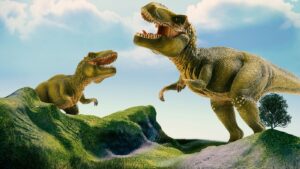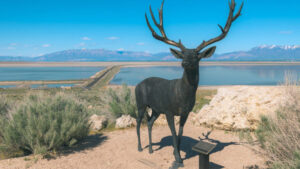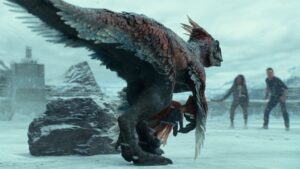Are Dinosaurs Dragons? Debunking Myths & Legends
Dinosaurs are not dragons; they were real creatures, unlike the mythical dragons. Dragons are fantastical beings from folklore and do not have a basis in scientific fact.
Dinosaurs roamed the Earth during the Mesozoic Era and have captivated the imaginations of scientists and the general public alike.
Representing a diverse group of reptiles, dinosaurs showcased a vast array of sizes, shapes, and ecological niches.
The fascination with these ancient animals has spurred numerous studies, leading to a rich understanding of their role in our planet’s history.
Though they share some characteristics, such as being reptilian and often large, the idea of dinosaurs as dragons is a romanticized myth, not supported by paleontological evidence.
The lore of dragons likely arose from the discovery of dinosaur fossils, yet it morphs into tales and legends far removed from the reality of these prehistoric giants.

Mythical Dragons Vs. Prehistoric Dinosaurs
The idea of dragons stirs the imagination. Fiery breath, massive wings, and fearsome roars fill the stories of old. Yet, how do these creatures stack up against the real gigantic lizards from our planet’s past?
This post explores the realm of mythical dragons versus prehistoric dinosaurs, diving into their differences and similarities.
Cultural Depictions Of Dragons
Dragons are powerful symbols in myths worldwide. Each culture has its tale, from Europe’s fire-breathing beasts to Asia’s wise serpents. Let’s explore how different societies imagined these legendary creatures.
- China: Dragons represent good luck and power.
- Europe: They often guard treasures or are foes to defeat.
- Americas: Serpent-like creatures like Quetzalcoatl.
Scientific Discoveries of Dinosaurs
Scientific Discoveries Of Dinosaurs
Unlike dragons, dinosaurs are grounded in science. They were real animals that walked the Earth millions of years ago. Scientists dig up fossils to learn about these amazing prehistoric beings.
| Dinosaur | Period | Diet |
|---|---|---|
| Tyrannosaurus Rex | Cretaceous | Carnivore |
| Triceratops | Cretaceous | Herbivore |
| Velociraptor | Cretaceous | Carnivore |
These prehistoric giants have captured modern hearts too. Fossils tell us about their bone structure, diet, and lifestyle. No myth here—these creatures were very real.
Fantasy Meets Paleontology: A Comparison
The idea of dinosaurs and dragons often inspires awe and fascination. But what happens when we peel back the layers of legend to compare these magnificent creatures?
Let’s dive into the realms of fantasy and science to explore the similarities and differences between dragons and dinosaurs, these behemoths of land and lore.
Physical Attributes Of Dragons And Dinosaurs
Dragons and dinosaurs captivate us with their size and strength. Despite existing in different realms—one in fossil records, the other in tales—comparing their physical characteristics reveals intriguing parallels and contrasts.
| Feature | Dragon | Dinosaur |
|---|---|---|
| Size | Varies, often massive | Varies from small to colossal |
| Scales | Typically depicted with scales | Some had scales, others had feathers |
| Wings | Often shown with wings | Most lacked wings, except pterosaurs |
| Tails | Long, might have special powers | Diverse tails, often used for balance |
Behavior In Myths And Fossil Evidence
While dragons are known for their fiery breath, dinosaurs are studied for their behaviors through fossil evidence.
Myths paint dragons as intelligent and often dangerous. Fossils show dinosaurs as diverse creatures, some predatory, others peaceful.
- Dragons: Portrayed as wise, fearsome, and hoarders of treasure.
- Dinosaurs: Evidence suggests varied diets and social structures.
Fossil evidence allows scientists to reconstruct scenes from eons past: hunting strategies, nesting habits, and even care for their young.
Legends, on the other hand, describe dragons as solitary creatures with magical abilities, often interacting with humans—either as protectors or destroyers.
The Influence Of Dinosaur Fossils On Dragon Myths
The Influence of Dinosaur Fossils on Dragon Myths
Dragons soar through the pages of folklore, breathing fire into our collective imagination. Yet, dinosaurs, the colossal creatures that once roamed the Earth, may have been the spark for these mythical beasts.
Historical Interpretations Of Fossils
Long before paleontology emerged as a science, unearthed bones of unknown creatures stirred wonder and speculation.
- Stories about giant beings filled the gap of understanding.
- Fossil discoveries often became linked with legends of dragons.
- Dragons could explain the mysterious bones in ancient times.
How Ancient Finds Might Have Sparked Dragon Tales
Imagine a farmer in ancient China or a knight in medieval Europe stumbling upon massive, dragon-like bones.
These finds might lead to belief in dragons, creatures of imposing size and mysterious origin.
- Skulls of triceratops or other large dinosaurs may resemble a dragon’s head.
- Vertebrae could be seen as a dragon’s backbone.
- Clawed limbs fuel stories of dragon encounters.
These parallels trigger the question, were dinosaurs the real-life dragons of the ancient world?
Deciphering Ancient Creatures In Art And Lore
The intersection of ancient creatures in art and lore opens a fascinating chapter in humanity’s cultural history.
For centuries, civilizations around the world depicted mighty beings that capture our imagination. Among them, dinosaurs and dragons stand out as colossal figures of awe and mystery.
This voyage into the past reveals how interpretations of these creatures have evolved and how they continue to excite our curiosity.
Iconography Evolution Of Dragons
Dragons have been mystical symbols throughout various cultures. Their appearances in art offer rich insights into societal beliefs and mythologies. Icons transform over time, reflecting changing values and knowledge.
- Eastern dragons, often benign and wise, represent power and good fortune.
- Western dragons, typically feared, depict chaos or evil to be conquered.
Artifacts like vases, tapestries, and sculptures showcase these variations. Discovering dragon depictions reveals shifts in artistic style and societal attitudes.
Reconstructing Dinosaur Appearances In Science And Art
Scientific progress shapes our understanding of dinosaurs. Fossil discoveries guide accurate representations, while artists interpret these findings.
| Period | Science Influence | Artistic Rendering |
|---|---|---|
| 19th Century | First fossils found | Dragons and sea serpents |
| Early 20th Century | More skeletal discoveries | Massive, sluggish reptiles |
| Late 20th Century | Dinosaur Renaissance | Dynamic, bird-like creatures |
| 21st Century | Advanced technology | Detailed, accurate depictions |
Modern reconstructions meld science with creativity. Paleontologists work with artists to imagine living dinosaurs based on skeletal structures and related species.
The quest continues as each discovery refines our perception of these ancient creatures, blending the lines between the dragons of myth and the dinosaurs of reality.
Separating Science From Fiction In Modern Times
The tales of dinosaurs and dragons fascinate minds across all ages. Yet, distinguishing between prehistoric facts and mythical legends is crucial.
With advances in science, we can now separate truth from tales. We explore how modern educational efforts clarify misconceptions. We also examine the dragons’ enduring presence in today’s culture.
Educational Efforts On Dinosaurs
Schools, museums, and media work hard to teach about dinosaurs. These are real creatures that once walked the Earth.
Interactive exhibits and accurate fossil replicas help bring science to life.
Educators use:
- Visual aids, like detailed images and diagrams
- Documentaries that show the latest research
- Workshops for hands-on learning experiences
Many books for kids feature true dinosaur facts. They show the difference between science and stories. This helps young minds learn what we really know.
Perpetuation Of Dragon Myths In Contemporary Culture
Dragons continue to capture our imaginations. Movies, books, and games keep these myths alive. Fascinating stories about dragons appeal to people of all ages.
| Media Type | Impact on Dragon Lore |
|---|---|
| Films | Visual storytelling gives dragons life |
| Books | Rich narratives create new dragon tales |
| Video Games | Interactive experiences engage with dragon myths |
Even with science making facts clear, dragons stay a symbol of wonder. The blend of fiction in books and films takes us to a world of fantasy. Magic and mystery surround dragons, keeping them popular in modern culture.
Frequently Asked Questions Of Are Dinosaurs Dragons
Is A Dragon Considered A Dinosaur?
No, a dragon is not considered a dinosaur. Dragons are mythical creatures, whereas dinosaurs were real, prehistoric animals.
Why Do Dinosaurs Look Like Dragons?
Dinosaurs and dragons share similarities due to human imagination interpreting fossil shapes in mythical ways. Cultural depictions of dragons often borrow features from discovered dinosaur bones.
Did Dragons Exist Before Dinosaurs?
Dragons are mythical creatures and did not exist before dinosaurs. Dinosaurs were real and lived millions of years ago.
Were Dinosaurs Called Dragons Before?
Yes, in many cultures, large prehistoric bones attributed to dragons may have actually belonged to dinosaurs.
Conclusion
Exploring the link between dinosaurs and dragons has been a captivating journey. We’ve uncovered myths, science, and the power of imagination. Both creatures stir our curiosity, yet reality separates them.
Dinosaurs are historical beings; dragons, tales’ whispers. Embrace these stories, but let’s honor the truth—dinosaurs, not dragons, walked the Earth.




